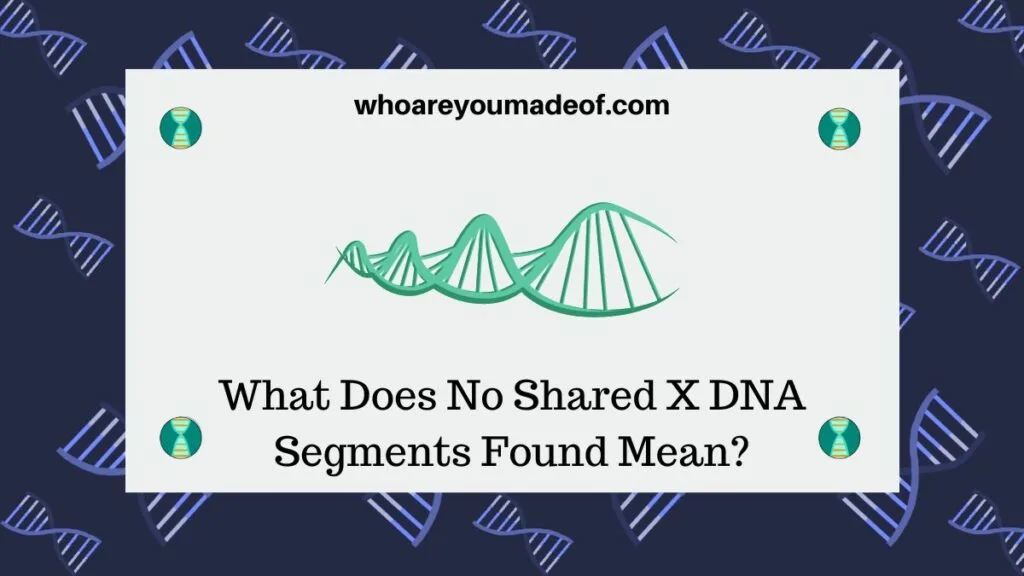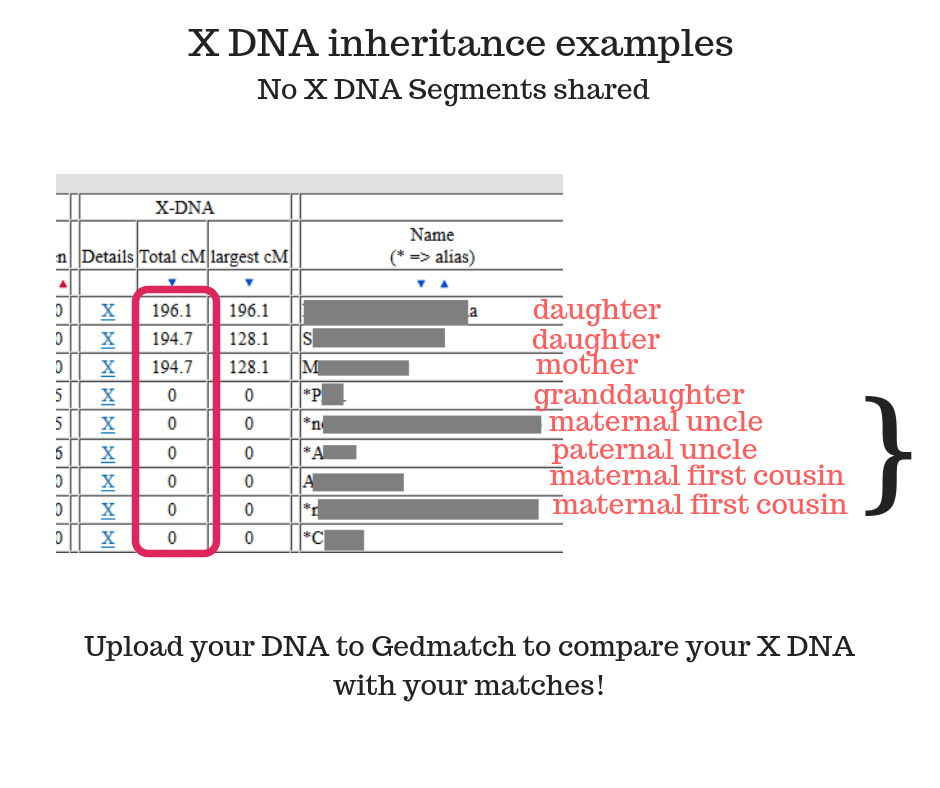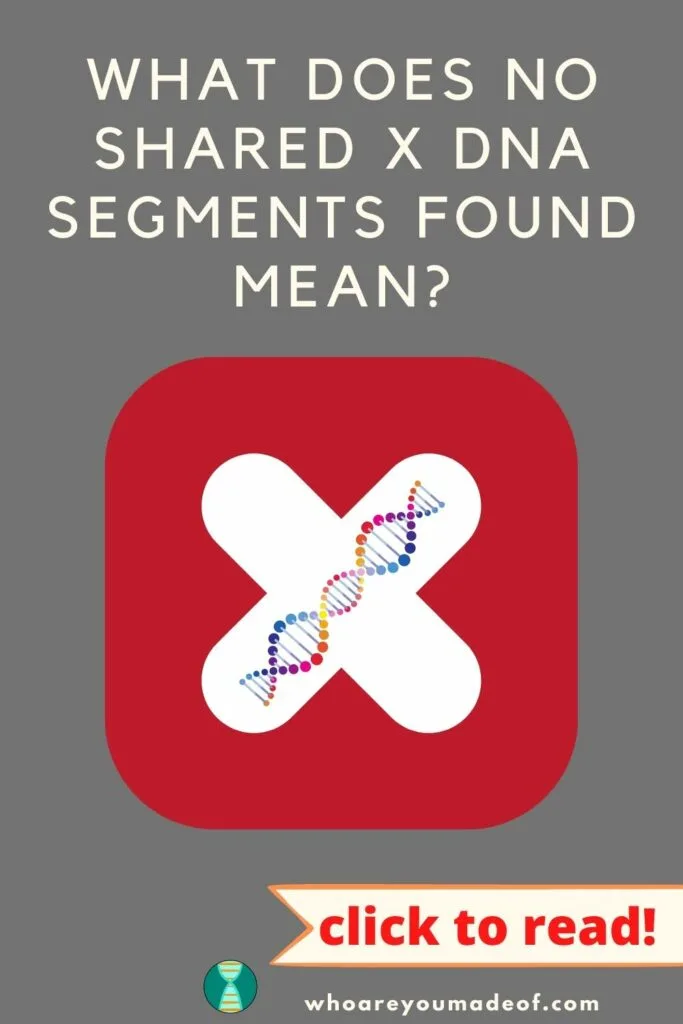Have you used the X DNA Comparison tool on Gedmatch? If so, you've probably seen a message saying, "No shared X DNA segments found".
In this post, I'll explain a little bit about X DNA and also help you understand what that message really means.

I try to make sure to address topics on this site that can be easily understood by beginners. X-DNA can be a little tricky, and so it does start to roam into the more "intermediate" of topics, but it's still important to understand the basics about this very unique aspect of our DNA.
Let's get started!
What is X DNA anyway?
We all have 22 numbered chromosomes and chromosome that determines our biological gender. On each chromosome, we have two "copies", one that we received from each of our parents.
Most of the time when we talk about DNA, we are talking about autosomal DNA which is contained within our numbered chromosomes. X DNA is special, however, and it's in one of our chromosomes that determines whether we are born biologically male or female.
We get one copy of each chromosome from each of our parents. That's right, one copy of every single numbered chromosome from both our mother and father.
However, the X-chromosome is passed down only from mothers to both their male and female children. Fathers pass down a Y-chromosome to their male offspring and an X chromosome to their daughters, which means that male children will have an XY on their 23rd chromosome, and female children will have XX.
The pair of chromosomes that determines whether the child is a male or a female contains either two copies of the X-chromosome or one copy of the X and one copy of a Y chromosome. If the offspring of a couple gets two X chromosomes, then the baby's biological gender is female.
If the child gets an X and a Y, then the baby's biological gender is male.
Since every male has an X and a Y chromosome, and every woman has two X chromosomes, you can see how their kids can only be either X and Y or X and X.
Just like with autosomal DNA, we can also share DNA segments on the X chromosome that match our relatives. The difference is that there is a special pattern of inheritance for X DNA.
For example, you might have noticed that females get X DNA from both their mother and father, while males only get X DNA from their mother.
One other important note related to X DNA inheritance is that when a female passes the X chromosome to her male or female offspring, the chromosome is almost always "recombined" with her other X chromosome to make a brand-new, unique copy. This means that the "new" X chromosome passed down to the daughter is basically made up of pieces from both of her X chromosomes.
Very occasionally, a female's X chromosomes are not recombined and just one of her copies of the chromosome is passed down "intact" to her offspring.
What does it mean to have no X DNA matching DNA segments?
At a most basic level, if your X DNA One-to-One results say that you don't share any X DNA segments with a person, then it means that you don't share any X DNA. In some situations, this can be meaningful.
As you might guess, because of the way in which X DNA is passed down, there are some people you will share X DNA with, and others with whom you'll share none.
It's usually more helpful to know if you do share X DNA with someone than it is to know that you don't, but it's still interesting to understand situations where close relatives don't share DNA.
Need some examples?
In the image below, you can see a list of DNA matches belonging to a male. The first few matches are his daughters and mother, with whom he does share an X chromosome. He inherited an X chromosome from his mother, and passed it down to each of his daughters.

Why doesn't this man share X DNA with his granddaughter?
It's possible, and even usual, for a granddaughter to share X DNA with her mother's father (because her mother did inherit an X chromosome from both her mother and father), but in the case that we see above, she doesn't.
In this case, this particular granddaughter inherited an entire X chromosome from her mother's mother, instead of the X chromosome being "recombined" with the grandfather's X chromosome. Recombination usually happens, but not always.
Recombination is when two copies of a chromosome "recombine" to make a brand-new, unique copy. Since females have two copies of the X-chromosome, the X-chromosome that the pass down to their children might contain pieces of both of their copies.
However, sometimes a fully intact copy of one of the mother's X-chromosomes is passed down to one or more of her offspring. When this happens, the child (or their descendants) will not have X-DNA matching one of their maternal grandparents.
Why doesn't this man share X DNA with his paternal uncle?
Our test taker inherited an X chromosome from his mother only. The paternal uncle inherited his X DNA from his mother, who was the test taker's grandmother.
Because of recombination, it's possible to share DNA with a paternal uncle, who would have received his X chromosome from our test taker's paternal grandmother. But, it's also possible that no recombination occurred when our test taker's father inherited his X chromosome from his mother.
There are a few ways to explain how there could be no match in this case.
Why doesn't this man share DNA with his maternal uncle?
This test taker's maternal uncle inherited his X DNA from his mother, and the test taker's mother inherited her X DNA from her mother and her father. The mother and the uncle of the test taker share a partial X chromosome, which means that the X that they inherited from their mother was likely recombined and passed down to either one of them, or both of them.
The test taker then inherited his X chromosome from his mother. We remember that one of his mother's X chromosomes only partially matched her brother (the test taker's uncle).
Because the test taker doesn't match the uncle, we can now assume that the mother's X chromosomes recombined to pass down to the test taker and doesn't include segments that matched the segments the uncle has.
Are there any definitive conclusions NOT sharing X DNA can provide?
There are a few very specific situations where NOT sharing X DNA can help determine how people are NOT related to each other. Lot's of confusing language in this blog post, I know!
Here are some common situations:
- Two half-SISTERS who don't share any X DNA definitely don't have the same father, since females will always inherit one entire X chromosome from their father (it can't recombine), a non-match with a possible female half-sibling means that they definitely don't share fathers. This is not true for half-siblings who are both male, or are male and female, or who possibly share the same mother.
- If you are female, a match with whom you share no X DNA cannot be your parent, since females share X DNA with both of their parents.
- If you are male, a female match with whom you share no X DNA cannot be your mother, since males inherit their X chromosome from their mother.
As you can see, there aren't many 100% sure conclusions that you can make based on the fact that two people don't share any X DNA. It's much more useful to learn from situations where you do share X DNA, but that is a post for another day!
Conclusions
X DNA is fun, crazy, and confusing at times. Nevertheless, I hope that this post helped you understand what it means when you don't share X DNA with a match. If you have any questions, comments, or concerns, I would love to hear from you in the discussion below.
Thanks for stopping by!


